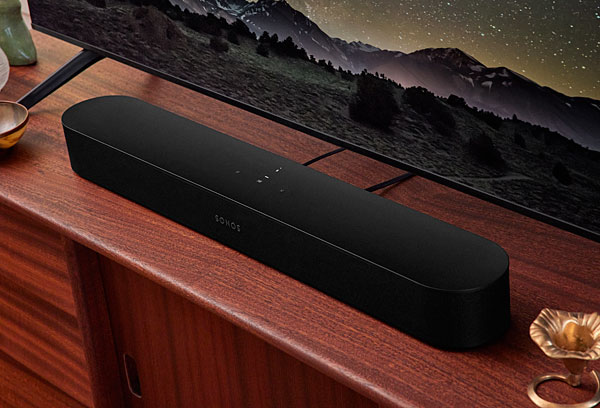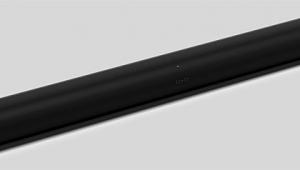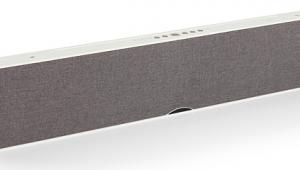Sonos Beam Gen 2 Soundbar Review Page 2
I found that if I cranked up the volume, the Sonos would intelligently reduce bass output, allowing me to exceed volume levels that would typically add distortion. But if you want a properly balanced sound with rich bass, short of adding a subwoofer it's best to back off on the Beam Gen 2's volume knob.
Of course, adding a Sonos SUB Gen 3 ($749) would hugely expand upon the soundbar's core performance, but adding one would also turn this into a $1,200 system. At around that price point, you can buy an impressive soundbar that features upfiring drivers for Atmos plus a wireless subwoofer and surrounds. My point here is that the Beam Gen 2 can serve as the foundation for a system, one you can expand by adding the company's SUB Gen 3 and Sonos One ($219/each) or One SL speakers ($199/each) for surrounds. But even if you don't want to go that route, it's got gusto all on its own and offers a sizable upgrade over any TV or ultra short throw projector's built-in audio.
Vocal clarity is essential for soundbar shoppers. For soundbar makers, there are two ways to deliver this: focus on intrinsic audio quality, or artificially accentuate dialogue. Sonos takes the former approach, thankfully, and the resultant clarity also yields benefits with lead vocals on music. I liked how I didn't need to fuss with various listening modes (Music, Game, Surround, etc.) to find one that sounds acceptable like I have had to do with some other soundbars.

But even with the Beam Gen 2's considerable capabilities (both DTS Digital Surround and Dolby Atmos music support was added via a firmware update after I had completed this review), its Atmos performance turned out to be a bit disappointing. My living room where I tested the soundbar has a flat, 11-foot-high ceiling. I tried listening for virtual height effects while watching Free Guy, but instead heard regular surround. The sound was clear, and it had a fullness one normally wouldn't expect from a standalone soundbar, but it also lacked the sense of elevation and three-dimensionality that a full-blown Atmos system can deliver.
To double-check this, I used the Dolby Access app on my Xbox One Series X to play some Atmos demo clips designed explicitly to show off 3D immersive sound. I've seen these clips many times over the years in dozens of demo systems. One clip in particular, Amaze, has raindrops that sound distinctly like they're falling on leaves above your head. And while I can say I was again impressed with the quality and expansiveness of the virtual Atmos sound, the sense of envelopment did not include much in terms of height.
That said, recalling that the Beam Gen 2 is a standalone $450 soundbar helped to put its performance in reasonable perspective. As I watched John Wick 3, the dimensionality conveyed by the mix matched the scene quite nicely, growing and shrinking according to room size in interior scenes and taking on a different character when outdoors.
I mentioned above that the Beam Gen 2 does not have listening modes per se. It does offer one option, Night Sound, that applies dynamic compression to make loud sounds quieter and quiet sounds louder so that everything is easier to hear and you don't disturb sleeping kids, spouses, or neighbors. I tried this out with movies and found it effective at reducing the vast volume swings that can occur when a film cuts from a quiet scene to one with intense action.
Along with movie soundtracks, the Beam Gen 2 excelled at reproducing TV sound, mainly the live sports broadcasts I watched. In this case, you can blast the soundbar at a high volume like you're having a party and it will focus its output power on the mid- and upper-range frequencies. As with movies, the formula here is simple: The Beam Gen 2 can play loud, but the louder you play it, the less bass there is in the mix, something that's irrelevant if your goal is to hear sports announcers.
With gaming, the Sonos did a great job rendering sounds in their proper location, except for behind my head, that is. Forza Horizon 4 on Xbox Series X has Atmos sound, so I set about doing some racing using just the soundbar, with the Hisense projector providing an immersive image. Between the 100-inch screen and the Beam Gen 2's audio, the sense of immersion was enough to draw me into the gaming environment.
But you don't necessarily need Atmos to enjoy an immersive gaming experience, and when I queued up my perennial favorite, Grand Theft Auto online (with my Sony PlayStation character, who is a rich man with many toys), the intricate sound effects of the world of Los Santos were rendered in surprising detail in an expansive panorama. The sonic image floated before me and seemed almost completely detached from the actual soundbar.
Before wrapping up my review, I measured the Beam Gen 2's frequency response using Room EQ Wizard software and a miniDSP UMIK-1, both from a one-meter distance and from the primary listening position after performing Trueplay tuning. The one-meter reading showed a bass output peak around 85 Hz, as well as bass response down to around 55-60Hz.

There was some roughness to the measured response curve at one meter, but the actual slope was reasonably linear. But then I took a reading from the primary listening position and my jaw dropped. The response at that spot and from adjacent seats was exceptionally smooth and resembled a proper "house curve" with a slight downward slope as frequencies increase. Long story short: Sonos Trueplay in the Beam Gen 2 offers effective room correction, a feature that most soundbars lack.
As a final point, I'll note both the reliability and ease-of-use of the Sonos app. I experienced zero glitches and found the interface when using Tidal HiFi to be responsive and pleasing. No other wireless speaker solution in my estimation offers quite reached the intuitive, plug-and-play, no-manual-needed experience as a Sonos.
Conclusion
On its own, the Sonos Beam Gen 2 does not compete with a typical Dolby Atmos A/V receiver and 5.1.2 speaker-based configuration. But in its modest yet overachieving manner, it does very much stand on its own for music, movies, and gaming. Like other Sonos speakers, you can increase its capabilities with further investment, and it can be incorporated into an extended multiroom system.
The Beam Gen 2 is a compelling option if you want a simple, high-quality soundbar that will "do it all"for under $500. As long as your TV features HDMI eARC, it can deliver a reasonably immersive Atmos experience. And even if your TV lacks that feature, the standard surround sound quality this compact soundbar delivers makes it a great choice.
- Log in or register to post comments




































































